Menus
- Power cruiser
- Strength of character
- The differences to the 1800 Intruder – Suzuki M 1500 Intruder
- Technical data Suzuki M 1500 Intruder
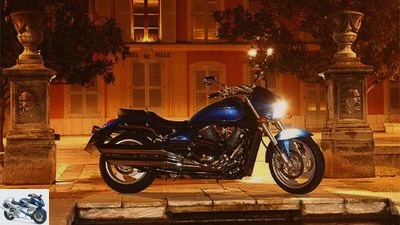
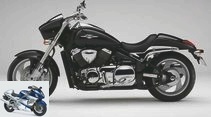
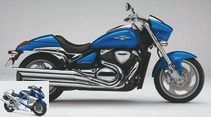
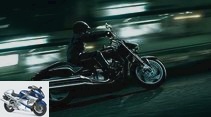
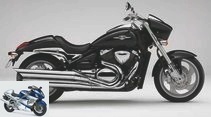
16 photos
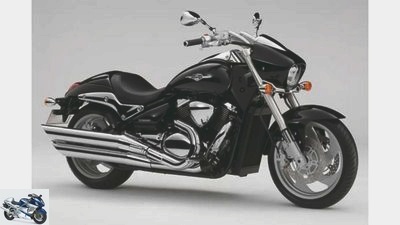
Suzuki
1/16
Suzuki’s new M 1500 cruiser.
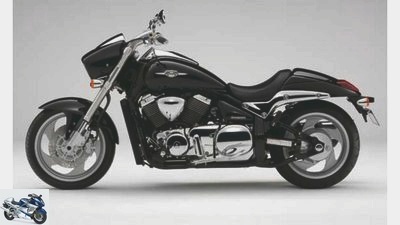
Suzuki
2/16
Suzuki’s new M 1500 cruiser.
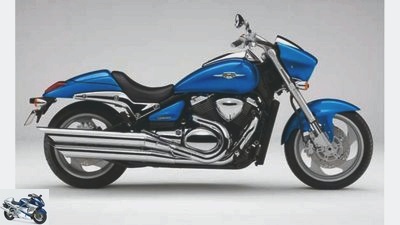
Suzuki
3/16
Suzuki’s new M 1500 cruiser.
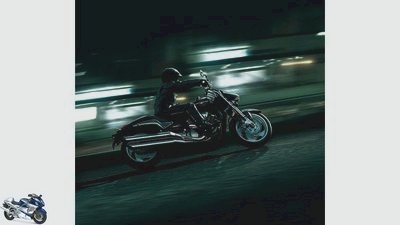
Suzuki
4/16
Stay cool …
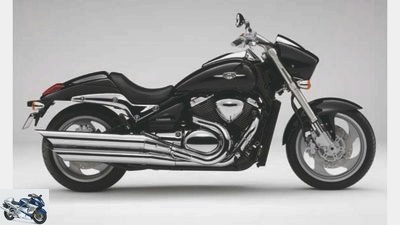
Suzuki
5/16
Suzuki’s new M 1500 cruiser.
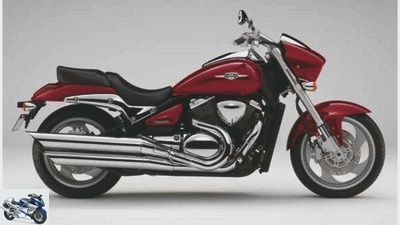
Suzuki
6/16
Suzuki’s new cruiser VZ 1500 – here with a pillion seat.
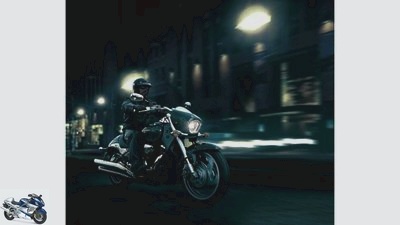
Suzuki
7/16
Nonchalance – home game for a cruiser like the M 1500.
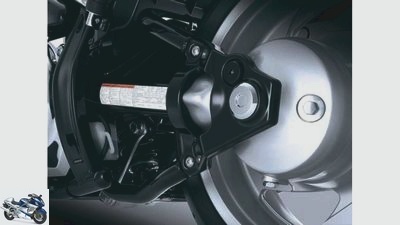
Suzuki
8/16
Easy to care for: the low-maintenance cardan drive.
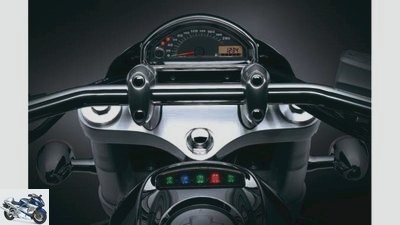
Suzuki
9/16
Analog speedometer, indicator lights on the tank.
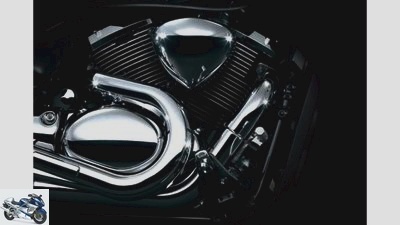
Suzuki
10/16
The twin is a long-stroke engine and gets by with one camshaft per cylinder.
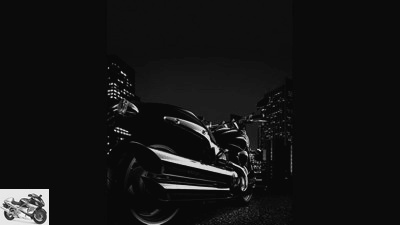
Suzuki
11/16
… to look cool afterwards.
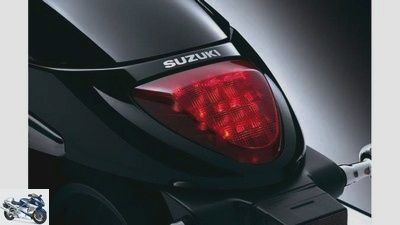
Suzuki
12/16
The rear of the M 1500 is also appealing.
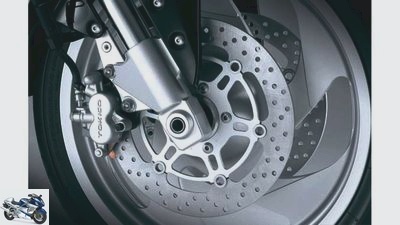
Suzuki
13/16
Suzuki’s new Cruiser M 1500: upside-down fork and conventional brakes.
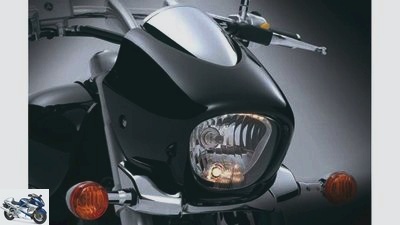
Suzuki
14/16
The lamp mask is copied from its big sister M 1800 R..
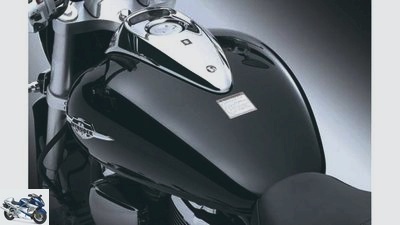
Suzuki
15/16
The 1500 looks really good on black.
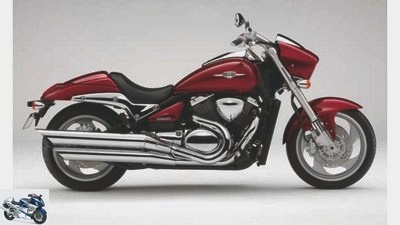
Suzuki
16/16
Suzuki’s new cruiser VZ 1500.
Test Suzuki M 1500 Intruder
Power cruiser
Suzuki’s new 1500 Intruder arouses desires: Her individual style, based on the older, larger 1800 sister, is well received on the show mile. Is the power cruiser a blender or a serious, independent character??
E.t is the eternal story of younger siblings who benefit from the freedom that the older ones still had to fight for. Applied to Suzuki’s Intruder family, this means that three years ago the M 1800 R paved the way for the brand new 1500 to walk. Okay, on the addition of ?? R ?? in the baptismal certificate she has to do without, but she looks like the big one. The same style, power look, subtly evil. Admiring glances do not stay away for long.
Viewed briefly, the new one from the 1800s is confusingly similar. Only when you look closely do subtle differences become apparent. To start with the stylish, streamlined lamp mask: Under the chrome-plated plastic screen, the analogue speedometer is located in the middle of the field of vision, which is atypical for a cruiser. On the other hand, nothing to see from a tachometer. So the search for differences continues up to the modified rear with its massive protection "sheet" (yes, plenty of plastic shines with a metallic sparkle), including a heart-shaped rear light made of light-emitting diodes: changes are rather cautious.
Artist
The "smaller ones" Intruder: Less displacement doesn’t mean less show.
Above all, that means: everything is one size smaller. So "just" XXL format instead of triple XL. This is especially true for the centerpiece, the mighty V2. It shares the unconventional 54-degree cylinder angle and four-valve heads with the 1800. However, only one overhead camshaft rotates in it, as in the blessed VL 1500. The bore and stroke also come from this, so the latest Trude is designed with a long stroke according to old-fashioned custom. In contrast to the short-stroke, easy-turning, nominally 125 hp big sister. A full 10.1 centimeter stroke of the 96 pistons promises a lot of punch from below. And a lot of casualness. A nominal output of 80 hp is completely sufficient for this. So the giant baby was lifted off the stand. In order to balance 330 kilograms in the vertical, the left leg must not lack strength, the will must not lack determination.
Strength of character
Tip: Open the steering lock on the right of the steering head beforehand and activate the ignition key on the left behind the rear cylinder before you get on. Just looks cooler. The Vau-Zwo responds to the push of a button with a deep sound from the two ultra-long stovepipes of the silencers. Sonor babbles Trude to himself, dull and bassy. It doesn’t matter that the 1800s sounds even more like a cross between marine diesel and paddle steamer in comparison. The driver lounges in a saddle, the width and comfort of which every cowboy would be jealous. It is a special experience to grasp the almost straight handlebar that is enthroned on high risers. The 18-liter tank spreads its legs wide, it looks like it can hold a whole barrel of fuel. Far in front you put your feet on the pegs. Well, then we can start.
The Intruder comes impatiently from the cable clutch. Logically, it presses almost 100 Newton meters on the crankshaft just above idling speed. The torque curve is plump like the back of a buffalo. The V2 reaches its peak of a measured 122 Newton meters at 2900 tours. But the surprise follows immediately. Despite the low speed level, the two-cylinder does not like low-speed driving. Tempo 30 in third gear or 50 in fifth and then pull up the gas? The engine room rumbles terribly, as if the engine wanted to tear the cardan shaft as thick as forearm to pieces. The final translation is simply too long, at 100 km / h in the fifth there are only 2300 tours. Therefore you have to downshift quite often; every 600 four-cylinder is more elastic. Just not so confident. The cartilaginous gearbox wants to be operated with vigor and acoustically it communicates the gear changes that are often necessary audibly at all times. But in the middle of the speed you surf a huge torque wave. Up to a speed of 140, the 1800s hardly pulls through better, only above that the paths of the two sisters, who are so different in character, separate inexorably. Just ?? who cruises in such spheres?
What the "Little ones" loses when accelerating, it gets it out again in corners. Their relatively moderate tire widths, 120 and 200 millimeters, require less lean angle than the fat rollers of the 1800s (130 and 240) for the same speed. In addition, the 1500 Suzi remains much more neutral and stable, and does not run after every tiny bump in the road with excessive motivation. And does not want to stand up so emphatically in an inclined position.
The differences to the 1800 Intruder – Suzuki M 1500 Intruder
– 1462 instead of 1783 cm3 displacement.
– Only one instead of two camshafts in both cylinder heads
Long instead of short stroke (96 mm bore with 101 mm stroke instead of 112
mm and 90.5 mm)
– Nominal output 80 instead of 125 hp, compression 9.5 instead of 10.5: 1
– Triangular swing arm made of steel instead of two-arm swing arm made of aluminum
– Six-inch rim with 200 mm rear tire instead of an 8.5-inch rim
240 rear roller
– 330 versus 348 kilograms of weight; no tachometer
– Tank capacity 18.0 instead of 19.5 liters
– Upside-down fork not adjustable, dip tubes with 43 instead of 46
Millimeter diameter
– Larger seat height: 730 instead of 700 millimeters
– No radially screwed four-piston brakes at the front, but
Double piston floating calipers
– Wheelbase and overall length slightly shorter, caster longer
Technical data Suzuki M 1500 Intruder
engine
Water-cooled two-cylinder four-stroke 54-degree V-engine, one overhead, chain-driven camshaft, four valves per cylinder, rocker arm, wet sump lubrication, injection, Ø 42 mm, regulated catalytic converter with secondary air system, alternator 425 W, battery 12 V / 18 Ah, mechanically operated multi-plate oil bath clutch, five-speed gearbox, cardan, secondary ratio 3.14.
Bore x stroke 96.0 x 101.0 mm
Cubic capacity 1462 cm³
Compression ratio 9.5: 1
Rated output 59.0 kW (80 PS) at 4800 rpm
Max. Torque 126 Nm at 2700 rpm
landing gear
Double loop frame made of steel, upside-down fork, Ø 43 mm, two-arm swing arm made of steel, central spring strut with lever system, adjustable spring base, double disc brake at the front, Ø 290 mm, double-piston floating calipers, blade-
rear brake, Ø 275 mm, double-piston floating caliper.
Cast aluminum wheels 3.50 x 18; 6.00 x 17
Tires 120/70 ZR 18; 200/50 ZR 17
Tires in the test
Bridgestone G 852/853 ?? G ?? Exedra
mass and weight
Wheelbase 1690 mm, steering head angle 58.0 degrees, caster 129 mm, suspension travel f / h 130/108 mm, weight with a full tank * 330 kg, payload * 220 kg, tank capacity 18 liters.
Guarantee: two years
Service intervals: every 6000 km
Colors: black, red, blue
Price: 11260 euros
Additional costs: around 230 euros
Readings
Performance
Top speed: 190 km / h
acceleration
0 100 km / h 4.6 sec
0 ?? 140 km / h 9.2 sec
Draft
60 ?? 100 km / h 4.4 sec
100 ?? 140 km / h 5.4 sec
140 180 km / h 17.0 sec
Speedometer deviation
Effective (display 50/100)
47/93 km / h
consumption
Country road 5.5 l / 100 km
Theor. Range 327 km
Fuel type normal
Related articles
-
Jahn comparison test Powercruiser Kawasaki VN 2000, Suzuki Intruder M 1800 R, Yamaha XV 1900 Midnight Star Punchtime Nobody distributes more displacement and …
-
MOTORRAD presents: Suzuki VL 1500 Intruder
MOTORRAD presents: Suzuki VL 1500 Intruder Trial of Power Now it’s going to be big: With unrestrained use of materials and plenty of displacement …
-
Impression Suzuki VS 1400 Intruder
fact Impression Suzuki VS 1400 Intruder Big in Japan It was Suzuki’s big Intruder, which with 1360 cubic centimeters in the second half of the 80s as …
-
fact Top-Test Suzuki GSR 600 Express yourself Getting noticed is more popular than ever today. And no longer just the big, prestigious classes …
-
Jahn Top-Test Suzuki B-King And yet so nice Suzuki’s B-King comes across as a real brutal bike, looks like it is eating small children. Your…
-
Blacksmith Suzuki M 1800 R Intruder Endurance test interim balance Cast off for a long-term trip with the Über-Cruiser, which has the thickest pistons in…
-
Comparison test muscle bikes Ducati Harley-Davidson Suzuki Yamaha
Gargolov 24 pictures Gargolov 1/24 The four muscle animals. Gargolov 2/24 Yamaha Vmax – Yes, that fits. The surge of combustion of the 200PS has to go through four …
-
Artist comparison test middle class Honda Hornet S Kawasaki ZR-7 S Suzuki GSF 600 S Bandit Yamaha FZS 600 Fazer Born to be mild Four days, 1913 …
-
Suzuki Gladius and Kawasaki ER-6n in comparison test
Blacksmith 16 photos Jahn 1/16 Suzuki Gladius and Kawasaki ER-6n in comparison test. Which of the 650 twin-cylinder has the edge in the end? Jahn 2/16…
-
Driving report Suzuki Intruder M 1800 R
Jahn Driving report Suzuki Intruder M 1800 R Strong smoker Suzuki sends clear smoke signals to the competition: The muscle cruiser M 1800 R comes with…